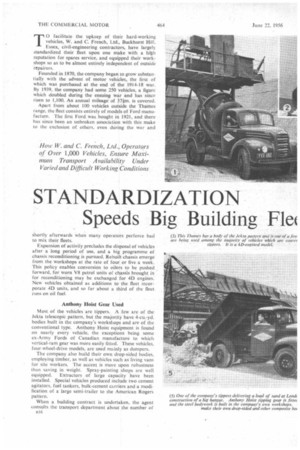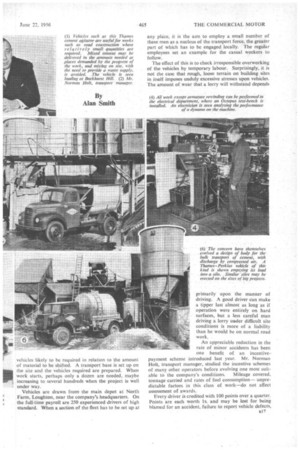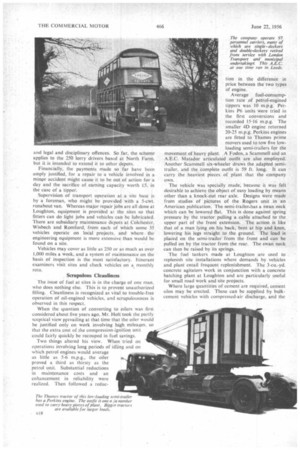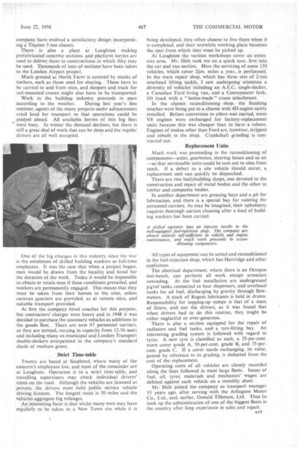STANDARDIZATION Speeds Big Building Flo
Page 50

Page 51

Page 52

Page 53

If you've noticed an error in this article please click here to report it so we can fix it.
How W. and C. French, Ltd., Operators of Over 1,000 Vehicles, Ensure Maximum Transport Availability Under Varied and Difficult Working Conditions
T0 facilitate the upkeep of their hard-working vehicles, W. and C. French, Ltd., Buckhurst Hill, Essex, civil-engineering contractors, have largely standardized their fleet upon one make with a high reputation for spares service, and equipped their workshops so as to be almost entirely independent of outside repairers.
Founded in 1870, the company began to grow substan • tially with the advent of motor vehicles, the first of which was purchased at the end of the 1914-18 war. By 1939, the company had some 250 vehicles, a figure which doubled during the ensuing war and has since risen to 1,100. An annual mileage of 37*m. is covered.
Apart from about 100 vehicles outside the Thames range, the fleet consists entirely of models of Ford manufacture. The first Ford was bought in 1921, and there has since been an unbroken association with this make to the exclusion of others, even during the war and shortly afterwards when many operators perforce had to mix their fleets.
Expansion of activity precludes the disposal of vehicles after a long period of use, and a big programme of chassis reconditioning is pursued. Rebuilt chassis emerge from the workshops at the rate of four or five a week. This policy enables conversion to oilers to be pushed forward, for worn V8 petrol units of chassis brought in for reconditioning may be exchanged for 4D engines. New vehicles obtained as additions to the fleet incorporate 4D units, and so far about a third of the fleet runs on oil fuel.
Anthony Hoist Gear Used
Most of the vehicles are tippers. A few are of the Jekta telescopic pattern, but the majority have 4-cu.-yd. bodies built in the company's workshops and are of the conventional type. Anthony Hoist equipment is found on nearly every vehicle, the exceptions being some ex-Army Fords of Canadian manufacture to which vertical-ram gear was more easily fitted. These vehicles, four-wheel-drive models, are used mainly as dumpers.
The company also build their own drop-sided bodies, employing timber, as well as vehicles such as living vans for site workers. The accent is more upon robustness than saving in weight. Spray-painting shops are well
equipped. Extractors of large capacity have been installed. Special vehicles produced include two cement agitators, fuel tankers, bulk-cement carriers and a modification of a large semi-trailer to the American Rogers pattern.
When a building contract is undertaken, the agent consults the transport department about the number of 1516
vehicles likely to be required in relation to the amount of material to be shifted. A transport base is set up on
II!the site and the vehicles required are prepared. When work starts, perhaps only a dozen are needed, maybe increasing to several hundreds when the project is well under way.
Vehicles are drawn from the main depot at North Farm, Loughton, near the company's headquarters. On the full-time payroll are 250 experienced drivers of high standard. When a section of the fleet has to be set up at any place, it is the aim to employ a small number of these men as a nucleus of the transport force, the greater part of which has to be engaged locally. The regular employees set an example for the casual workers to follow.
The effect of this is to check irresponsible overworking of the vehicles by temporary labour. Surprisingly, it is not the case that rough, loose terrain on building sites in itself imposes unduly excessive stresses upon vehicles. The amount of wear that a lorry will withstand depends primarily upon the manner of driving. A good driver can make a tipper last almost as long as if operation were entirely on hard surfaces, but a less careful man driving a lorry uader difficult site conditions is more of a liability than he would be on normal road work.
An appreciable reduction in the rate of minor accidents has been one benefit of an incentivepayment scheme introduced last year. Mr. Norman Holt, transport manager, studied the incentive schemes of many other operators before evolving one most suit able to the company's conditions. Mileage covered. tonnage carried and rates of fuel consumption— unpredictable factors in this class of work—do not affect assessment of awards.
Every driver is credited with 100 points over a quarter. Points are each worth Is. and may be lost for being blamed for an accident, failure to report vehicle defects,
and legal and disciplinary offences. So far, the scheme applies to the 250 lorry drivers based at North Farm, but it is intended to extend it to other depots.
Financially, the payments made so far have been amply justified, for a repair to a vehicle involved in a minor accident might cause it to be out of action for a day and the sacrifice of earning capacity worth 1:5, in the case of a tipper.
Supervision of transport operation at a site base is by a foreman, who might be provided with a 5-cwt. runabout van. Whereas major repair jobs are all done at Loughton, equipment is provided at the sites so that fitters can do light jobs and vehicles can be lubricated. There are subsidiary maintenance depots at Colchester. Wisbech and Romford, from each of which some 35 vehicles operate on local projects, and where the engineering equipment is more extensive than would be found on a site.
Vehicles may cover as little as 250 or as much as over 1,000 miles a week, and a system of maintenance on the basis of inspection is the most satisfactory. Itinerant examiners visit sites and check vehicles on a monthly rota.
Scrupulous Cleanliness
The issue of fuel at sites is in the charge of one man. who does nothing else. This is to prevent unauthorized filling. Cleanliness is recognized as vital to trouble-free operation of oil-engined vehicles, and scrupulousness is observed in this respect.
When the question of converting to oilers was first considered about five years ago, Mr. Holt took the partly sceptical view prevailing at that time that the oiler would be justified only on work involving high mileages, so that the extra cost of the compression-ignition unit could fairly quickly be recouped in fuel savings.
Two things altered his view. When tried on operations involving long periods of idling and on which petrol engines would average as little as 5-6 m.p.g., the oiler proved a third as thirsty as the petrol unit. Substantial reductions in maintenance costs and an enhancement in reliability were realized. Then followed a reduc don in the difference in price between the two types e.f engine.
Average fuel-consumption rate of petrol-engined tippers was 10 m.p.g. Perkins P6 units were tried in the first conversions and recorded 15-16 m.p.g. The smaller 4D engine returned 20-25 m.p.g. Perkins engines are fnted to Thames prime movers used to tow five lowloading semi-trailers for the movement of heavy plant. A Foden, a Scammell and an A.E.C. Matador articulated outfit are also employed. Another Scammell six-wheeler draws the adapted semitrailer, and the complete outfit is 59 ft. long. It can carry the heaviest pieces of plant that the company own.
The vehicle was specially made, because it was felt desirable to achieve the object of easy loading by means other than a knock-out rear axle. Designs were made from studies of pictures of the Rogers unit in an American publication. The semi-trailer-has a swan neck which can be lowered flat. This is done against spring pressure by the tractor pulling a cable attached to the upper part of the front extension. The action is like that of a man lying on his back, bent at hip and knee, lowering his legs straight to the ground. The load is placed on the semi-trailer from the front and can be pulled on by the tractor from the rear. The swan neck can then be raised by its springs.
The fuel tankers made at Loughton are used to replenish site installations where demands by vehicles and plant entail frequent replenishment. The 3-cu.-yd. concrete agitators work in conjunction with a concrete batching plant at Loughton and are particularly useful for small road work and site projects.
Where large quantities of cement are required, cement silos may be erected. These can be supplied by bulkcement vehicles with compressed-air discharge, and the company have evolved a satisfactory design incorporating a Thames 5-ton chassis.
There is also a plant at Loughton making prefabricated concrete sections, and platform lorries are used to deliver them to constructions in which they may be used. Thousands of tons of sections have been taken to the London Airport project.
Much ground at North Farm is covered by stocks of timbers, such as those used for shoring. These have to be carried to and from sites, and sleepers and track for rail-mounted cranes might also have to be transported.
Work in the building industry proceeds in pace according to the weather. During last year's fine summer, agents of the many projects under advancement cried loud for transport so that operations could be pushed ahead. All available lorries of this big fleet were busy. In winter the demand declines, but there is still a great deal of work that can be done and the regular drivers are all well occupied.
One of the big changes in this industry since the war is the enrolment of skilled building workers as full-time employees. It was the case that when a project began, men would be drawn from the locality and hired for the duration of the work. Today it would be impossible to obtain or retain men if these conditions prevailed, and workers are permanently engaged. This means that they must be taken from their homes to the sites, unless caravan quarters are provided, as at remote sites, and suitable transport provided.
At first the company hired coaches for this purpose, but contractors' charges were heavy and in 1948 it was decided to purchase the necessary vehicles as additions to the goods fleet. There are now 97 personnel carriers, as they are termed,. varying in capacity from 12-56 seats and including many ex-municipal and London Transport double-deckers overpainted in the company's standard , shade of medium green.
Strict Time-table
Twenty are based at Southend, where many of the concern's employees live, and most of the remainder are at Loughton. Operation is to a strict time-table, and travelling supervisors may check individual drivers' times on the road. Although the vehicles are licensed as private, the drivers must hold public service vehicle driving licences. The longest route'is 50 miles and the vehicles aggregate big mileages.
An interesting facet is that whilst many men may have regularly to be taken to a New Town site while it is being developed, they often choose to live there when it is completed, and their erstwhile working place becomes the spot from which they must be picked up.
At Loughton the various workshops cover an extensive area. Mr. Holt took me on a quick tour, first into the car and van section. Here the servicing of some 150 vehicles, which cover 2im. miles a year, is performed. In the main repair shop, which has three sets of 2-ton overhead lifting tackle, I saw undergoing attention a diversity of vehicles including an A.E.C. single-decker, a Canadian Ford living van, and a Conveyancer forklift truck with a "home-made "crane attachment.
In the chassis reconditioning shop, the finishing touches were being put to a chassis with 4D engine newly installed. Before conversion to oilers was started, worn V8 engines were exchanged for factory-replacement units because this was cheaper than to have a rebore. Engines of makes other than Ford are, however, stripped and rebuilt in the shop. Crankshaft grinding is contracted out.
Replacement Units
Much work was proceeding in the reconditioning of components—axles, gearboxes, steering boxes and so on —so that serviceable units could be sent out to sites from stock. If a defect to a site vehicle should occur, a replacement unit can quickly be dispatched.
There are two bodybuilding shops, one devoted to the construction and repair of metal bodies and the other to timber and composite bodies.
In another department are greasing bays and a pit for lubrication, and there is a special bay for valeting the personnel carriers. As may be imagined, their upholstery requires thorough suction cleaning after a load of building workers has been carried.
All types of equipment can be tested and reconditioned in the fuel-injection shop, which has Hartridge and other appliances.
The electrical department. where there is an Octopus test-bench, can perform all work except armature rewinding. At the fuel installation are underground pyrol tanks connected to four dispensers, and overhead tanks for oil fuel, discharging by gravity through flowmeters. A stock of Regent lubricants is held in drums. Responsibility for topping-up sumps is that of a team of fitters, and not the drivers, as it was found that when drivers had to do this routine, they might be either neglectful or over-generous.
There is also a section equipped for the repair of radiators and fuel tanks, anda tyre-fitting bay. An interesting grading system is followed with regard to tyres. A new tyre is classified as such, a 25-per-cent. worn cover grade A, 50-per-cent. grade B, and 75-percent. grade C. If a cover needs exchanging, its value. gained by reference to its grading, is deducted from the cost of the replacement.
Operating costs of all vehicles are closely recorded along the lines followed in most large fleets. Issues of fuel, oil, tyres, materials and mechanics' wages arc debited against each vehicle on a monthly sheet. Mr. Holt joined the company as transport manager 15 years ago, after serving with the Arlington Motor Co., Ltd., and, earlier, Oswald Tillotson, Ltd. Thus he took up the administration of one of the biggest fleets in the country after long experience in sales and repair.




































































































